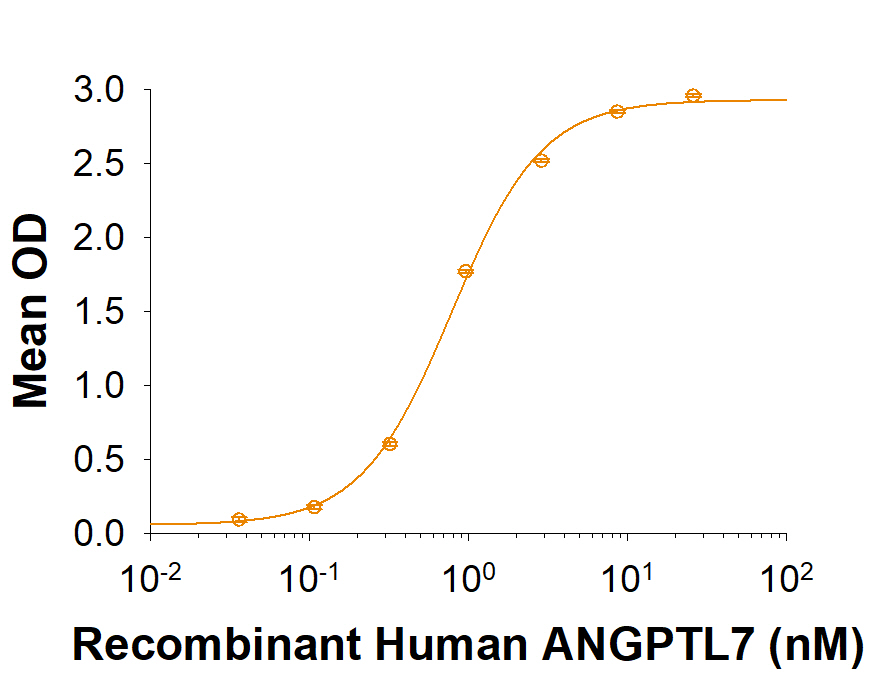Recombinant Human LILRB4/CD85k/ILT3 Protein, CF
Recombinant Human LILRB4/CD85k/ILT3 Protein, CF Summary
Product Specifications
Analysis
Product Datasheets
Carrier Free
CF stands for Carrier Free (CF). We typically add Bovine Serum Albumin (BSA) as a carrier protein to our recombinant proteins. Adding a carrier protein enhances protein stability, increases shelf-life, and allows the recombinant protein to be stored at a more dilute concentration. The carrier free version does not contain BSA.
In general, we advise purchasing the recombinant protein with BSA for use in cell or tissue culture, or as an ELISA standard. In contrast, the carrier free protein is recommended for applications, in which the presence of BSA could interfere.
8488-T4
| Formulation | Lyophilized from a 0.2 μm filtered solution in PBS. |
| Reconstitution | Reconstitute at 100 μg/mL in PBS. |
| Shipping | The product is shipped at ambient temperature. Upon receipt, store it immediately at the temperature recommended below. |
| Stability & Storage: | Use a manual defrost freezer and avoid repeated freeze-thaw cycles.
|
Scientific Data
 View Larger
View Larger
When Recombinant Human LILRB4/CD85k/ILT3 is coated at 2 µg/mL, Recombinant Human Angiopoietin-like Protein 7/ANGPTL7 (Catalog # 914-AN) binds with an apparent Kd<1 nM.
Reconstitution Calculator
Background: LILRB4/CD85k/ILT3
ILT3, also known as CD85k and LIR-5, is an approximately 60 kDa transmembrane glycoprotein that negatively regulates immune cell activation (1). Mature human ILT3 consists of a 238 amino acid (aa) extracellular domain with two Ig-like domains, a 21 aa transmembrane segment, and a 168 aa cytoplasmic domain with 3 immunoreceptor tyrosine-based inhibitory motifs (ITIM) (2). Alternative splicing of human ILT3 generates an isoform that lacks the first ITIM and a secreted isoform that circulates in the serum of cancer patients (3, 4). ILT3 is expressed on dendritic cells (DC), monocytes, macrophages, and vascular endothelial cells (EC) (2, 5, 6). Ligation of ILT3 triggers ITIM-mediated inhibition of cell-activating signaling, leading to enhanced immune tolerance and reduced allogeneic graft rejection (2, 4, 7, 8). Soluble ILT3 induces the differentiation of CD8 + T suppressor cells (Ts) that can inhibit the effector functions of CD4 + Th cells and CD8 + CTL (4, 7, 9). In turn, CD8 + Ts cells induce ILT3 up-regulation and a tolerogenic phenotype in monocytes, DC, and EC (5, 6, 8, 10, 11).
- Vlad, G. et al. (2010) Int. Rev. Immunol. 29:119.
- Cella, M. et al. (1997) J. Exp. Med. 185:1743.
- Heinzmann, A. et al. (2000) Eur. J. Immunogenet. 27:121.
- Suciu-Foca, N. et al. (2007) J. Immunol. 178:7432.
- Gleissner, C.A. et al. (2007) Eur. J. Immunol. 37:177.
- Manavalan, J.S. et al. (2004) Int. Immunol. 16:1055.
- Vlad, G. and N. Suciu-Foca (2012) Exp. Mol. Pathol. 93:294.
- Chang, C.C. et al. (2002) Nat. Immunol. 3:237.
- Vlad, G. et al. (2006) Int. Immunopharmacol. 6:1889.
- Manavalan, J.S. et al. (2003) Transpl. Immunol. 11:245.
- Brenk, M. et al. (2009) J. Immunol. 183:145.
FAQs
No product specific FAQs exist for this product, however you may
View all Proteins and Enzyme FAQsReviews for Recombinant Human LILRB4/CD85k/ILT3 Protein, CF
There are currently no reviews for this product. Be the first to review Recombinant Human LILRB4/CD85k/ILT3 Protein, CF and earn rewards!
Have you used Recombinant Human LILRB4/CD85k/ILT3 Protein, CF?
Submit a review and receive an Amazon gift card.
$25/€18/£15/$25CAN/¥75 Yuan/¥2500 Yen for a review with an image
$10/€7/£6/$10 CAD/¥70 Yuan/¥1110 Yen for a review without an image
